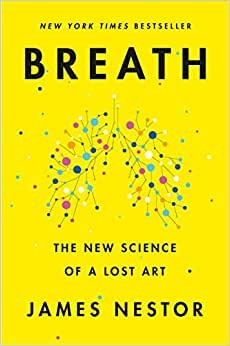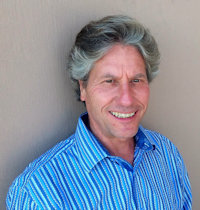Breath: The New Science of a Lost Art

from amazon.com
There is nothing more essential to our health and well-being than breathing: take air in, let it out, repeat twenty-five thousand times a day. Yet, as a species, humans have lost the ability to breathe correctly, with grave consequences.
Journalist James Nestor travels the world to figure out what went wrong and how to fix it. The answers aren’t found in pulmonology labs, as we might expect, but in the muddy digs of ancient burial sites, secret Soviet facilities, New Jersey choir schools, and the smoggy streets of São Paulo. Nestor tracks down men and women exploring the hidden science behind ancient breathing practices like Pranayama, Sudarshan Kriya, and Tummo and teams up with pulmonary tinkerers to scientifically test long-held beliefs about how we breathe.
Modern research is showing us that making even slight adjustments to the way we inhale and exhale can jump-start athletic performance; rejuvenate internal organs; halt snoring, asthma, and autoimmune disease; and even straighten scoliotic spines. None of this should be possible, and yet it is.
Drawing on thousands of years of medical texts and recent cutting-edge studies in pulmonology, psychology, biochemistry, and human physiology, Breath turns the conventional wisdom of what we thought we knew about our most basic biological function on its head. You will never breathe the same again.
Author: James Nestor
James Nestor is an author and journalist who has written for Outside Magazine, The Atlantic, National Public Radio, The New York Times, Scientific American, Dwell Magazine, The San Francisco Chronicle, and more.
Reviewed by: John Stokdijk

Breath work is currently a fad. But is it more than that? The Ajijic Book Club selection for May 2021, Breath: The New Science of a Lost Art by James Nestor promises to have the answer. Nestor is a professional writer and Breath was several years in the making. It became a NYT Best Seller.
Although Nestor did considerable research on his subject, he adds his own experience, an extraordinary experience.
I’d come here on the recommendation of my doctor, who’d told me, “A breathing class could help.” ...I kept breathing but nothing happened. No calmness swept over me; no tension released from my tight muscles. Nothing… Ten, maybe 20 minutes passed… Then something happened. I wasn’t conscious of any transformation taking place. I never felt myself relax or the swarm of nagging thoughts leave my head. But it was as if I’d been taken from one place and deposited somewhere else. It happened in an instant.
I worked to understand what had happened, and I spent the next several years trying to figure it out.
I have never had an extraordinary experience of any kind. I am neither seeking such an experience nor am I trying to avoid one. If it happens, fine, and if not, that is also fine. But I am interested in learning more about these kinds of experiences. I try to balance an openness to the experiences of others with some healthy skepticism.
I liked the way Nestor approached breathing.
This book will explore many things: evolution, medical history, biochemistry, physiology, physics, athletic endurance, and more. But mostly it will explore you.
While the research was interesting, without connections to my life now, I probably would not have read this book. Nestor made his book personal. As a result of reading Breath, I have made some changes that I will share later.
Part One THE EXPERIMENT describes research conducted by Dr. Jayakar Nayak at Stanford. James Nestor and Anders Olsson from Sweden, a colorful character, were patients in the program and are a part of the story told in this book. They were forced to become mouthbreathers by having their noses plugged.
Part Two THE LOST ART AND SCIENCE OF BREATHING surveys some of the historical research into breathing practices, ancient and modern.
Part Three BREATHING+ has more research and more advice on advanced breathing techniques.
Collectively, I’m calling these potent techniques Breathing+, because they build on the foundation of practices I described earlier in this book, and because many require extra focus and offer extra rewards.
I did find the science of breathing somewhat overwhelming, too much information to fully absorb and retain. It is my intention to go back to this book from time to time, using it as a resource. This book is more about how we live than a book of ideas to discuss.
Breath has spurred me to action. I have tried to become a nose breather all the time, except when I am running. I have tried to enhance my mindfulness breathing awareness.
I purchased the premium version of the Prana Breath Guru app for my smartphone. For the last couple of months I have been doing breathing exercises several times per day. I have also modified my physical exercises using elastic bands to now include rhythmic breathing.
To date, I have not noticed any benefits from my new activities but my intention is to continue down this path for the foreseeable future.
In Epilog of Breath are some simple recommendations.
SHUT YOUR MOUTH
BREATHE THROUGH YOUR NOSE
EXHALE
CHEW
BREATHE MORE, ON OCCASION
HOLD YOUR BREATH
Finally, James Nestor puts breath work into proper perspective.
What I explained to each of these people, and what I’d like to make clear now, is that breathing, like any therapy or medication, can’t do everything. Breathing fast, slow, or not at all can’t make an embolism go away. Breathing through the nose with a big exhale can’t reverse the onset of neuromuscular genetic diseases. No breathing can heal stage IV cancer. These severe problems require urgent medical attention.
